A Private Tour today. The mission was somewhat different to normal tours – with a concerted effort to find some of the lingering rarities which are around North Norfolk at the moment, as well as catching up with some of our scarcer wintering species. It was going to be an all action day!
It dawned very frosty and with a bit of lingering fog, although the sun was already doing its best to burn that off. We met in Wells and, after a quick look in the harbour on the way which didn’t produce anything noteworthy today, we made our way along to Holkham where we pulled in just off the road to scan the grazing marshes below.
We quickly located a good selection of geese. A long line of birds on the frozen grass beyond the hedge revealed themselves to be mostly White-fronted Geese, with an obvious white blaze around the base of their all-pink bills and orange legs. In with them, was a small group of Pink-footed Geese, very dark-headed with pink legs and a small, mostly dark bill with a pink band around it. There were also plenty of Greylag Geese too, much larger and paler with a large orange carrot of a bill, and a pair of Egyptian Geese.
 White-fronted Geese – out on the frozen grass at Holkham
White-fronted Geese – out on the frozen grass at Holkham
We could hear Pink-footed Geese calling and see odd groups flying back and forth in front of the pines, but it was only when we moved so that we could see round past the hedge and look out further over on the freshmarsh, that we could see just how many were out there. Thousands of birds were huddled together out on the grass and around the frozen pools. The Pink-footed Geese roost on the marshes here and would normally fly inland to feed during the day, but perhaps the lingering fog and frost had caused them to stay this morning. They were quite a sight!
A careful scan of the marshes and a white shape was just visible half-hidden in the reeds towards the back. When it put its neck up, we could see through the scope that it was the Great White Egret that has been hanging around here for several months. It was hard to see well in the reeds, but thankfully it flew, first to a small area of marsh nearby and then across and into the trees where it perched on a branch in full view.
 Great White Egret – flew up into the trees where it was easier to see
Great White Egret – flew up into the trees where it was easier to see
That was a great way to start, then we carried on west along the coast. With the remains of the fog burning off slowly, we made another stop at Brancaster Staithe to have a quick look in the harbour. A smart drake Red-breasted Merganser and a pair of Goldeneye were diving in the harbour channel. A little posse of Brent Geese were chattering noisily from the water’s edge, before flying off over the saltmarsh to feed.
 Brent Geese – gathering in the harbour channel
Brent Geese – gathering in the harbour channel
There was a nice selection of waders on view here too. A group of Bar-tailed Godwits and Oystercatchers were roosting on the edge of the water, with a Curlew standing head and shoulders above them. Nearby, a Black-tailed Godwit gave a good opportunity to go through the key differences from the Bar-taileds. A couple of Grey Plovers were higher up on the mud. Where someone had hauled up and washed a load of Brancaster mussels, two Turnstones were picking around in the debris. Down on the sandbars in the channel, we could see several Redshanks but a Greenshank unfortunately only flew up briefly as a Marsh Harrier passed overhead, before dropping down out of sight again.
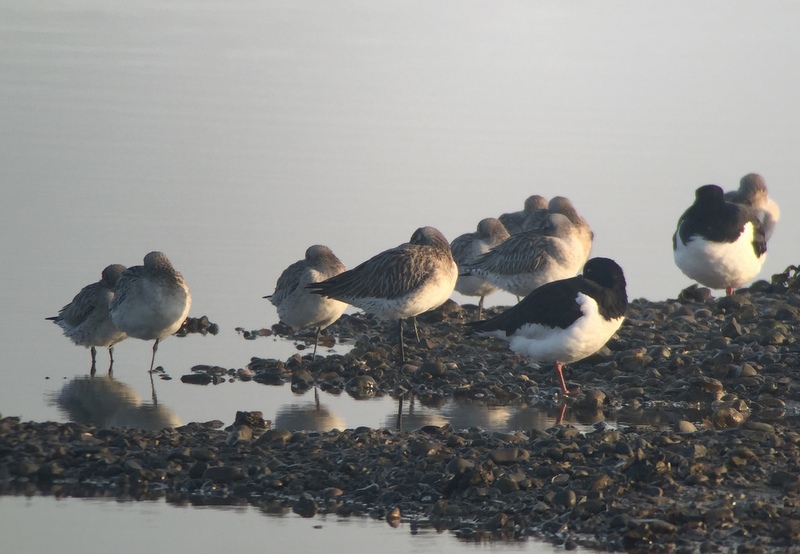 Bar-tailed Godwits & Oystercatchers – roosting in the harbour
Bar-tailed Godwits & Oystercatchers – roosting in the harbour
The sun was now starting to come through more strongly, burning off the mist, so we decided to have a drive round via Choseley to see if we could find the Rough-legged Buzzard. Driving along the lane, we spotted a harrier working its way low along a hedge beyond, into the sun from us. It looked slim-built so we tried to catch up with it. As it dropped ahead of us along the side of the road, we got a flash of a white rump patch and it landed briefly, before continuing its journey east across the fields. We could confirm it was a Hen Harrier, a ringtail, working the hedges.
Scanning the hedges all around, we could see our first Buzzard but it was clearly too dark, a Common Buzzard. Over the other side of the road, two more Common Buzzards were perched up in the morning sun, and away in the distance beyond we could see yet another. They were all out warming up in the sunshine, but try as we might we could not find a Rough-legged Buzzard doing the same. We drove round to the corner south of the drying barns, were a couple of cars were just leaving. When we asked what they had seen, we were told they had been watching the Rough-legged Buzzard and, even better, it was still in view. Unfortunately, a quick look confirmed it was actually another Common Buzzard, looking rather pale-breasted in the morning sunshine, but not like a Rough-legged Buzzard should. We had a quick and unsuccessful drive round some of the Rough-legged Buzzard’s other favourite haunts and then decided to move on.
We had a particular request to try for the Pallid Harrier today, which has been gracing various sites around Norfolk since we first saw it back in mid-November. In recent weeks it has been seen inland, around the village of Flitcham, but it typically only makes intermittent flights over the fields here, before disappearing off to hunt elsewhere.
We arrived and stationed ourselves at one end of the fields where a small group were scanning the thick hedge and cover strip in front. There were lots of Chaffinches flying up and down from the field to the hedge and in with them we could see a few Bramblings. Three Yellowhammers flew into the hedge as well and perched up so we could get them in the scope. We could hear Tree Sparrows calling as well. The Pallid Harrier had made a pass over the stubble field here about twenty minutes before we arrived, so we waited hopefully for it to return.
Thankfully we hadn’t been waiting very long when we got a surprise. There were others looking out over the fields a short way further along the road, but they hadn’t shouted anything across to us. It was only when a minibus pulled up alongside that we were kindly informed that the Pallid Harrier was actually being watched in a tree over there! We hastened down and sure enough, there it stood. We got a great look at it in the scope.
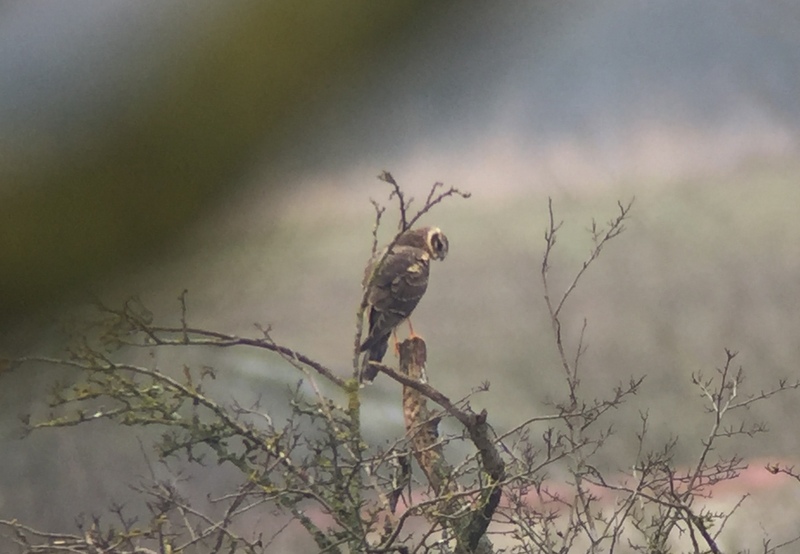 Pallid Harrier – perched up in a tree at Flitcham
Pallid Harrier – perched up in a tree at Flitcham
We were just making our way a little further along to join the crowd there for a closer view when it became clear it had taken off – apparently, someone had got a little too enthusiastic and had tried to go into the field, so scaring it off. Very helpful! It disappeared off over the fields beyond, so we had a quick look to see if it would loop round and do a circuit over the stubble again, but there was no sign of it. We had a number of other things we wanted to see today, and with our main target here achieved, we decided to move on.
As we walked along the road, we could hear Tree Sparrows calling again and when all the finches flew up into the hedge from the weedy strip beyond, we got a good view of a Tree Sparrow right in front of us. Historically a common farmland bird here, they are now getting very scarce and it is always nice to catch up with them. There were also lots of Bramblings in the hedge here too.
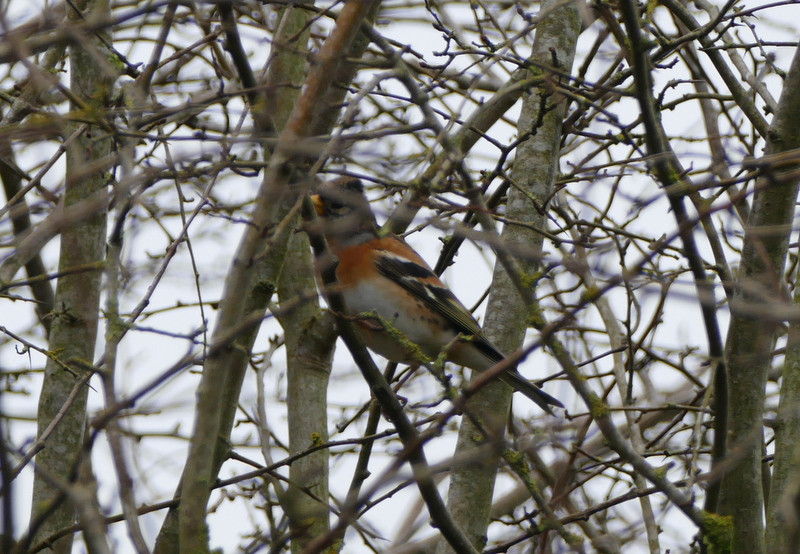 Brambling – lots were in the hedges at Flitcham
Brambling – lots were in the hedges at Flitcham
We made our way back towards the coast, and dropped down towards Titchwell via Choseley. We pulled up to talk to another birder in the layby where we had been earlier and were told the Rough-legged Buzzard had been reported again about half an hour earlier. A quick scan and there it was, perched in a tree in the distance. It really stood out with its striking pale head and contrasting black belly patch, very unlike the Common Buzzards we had seen earlier.
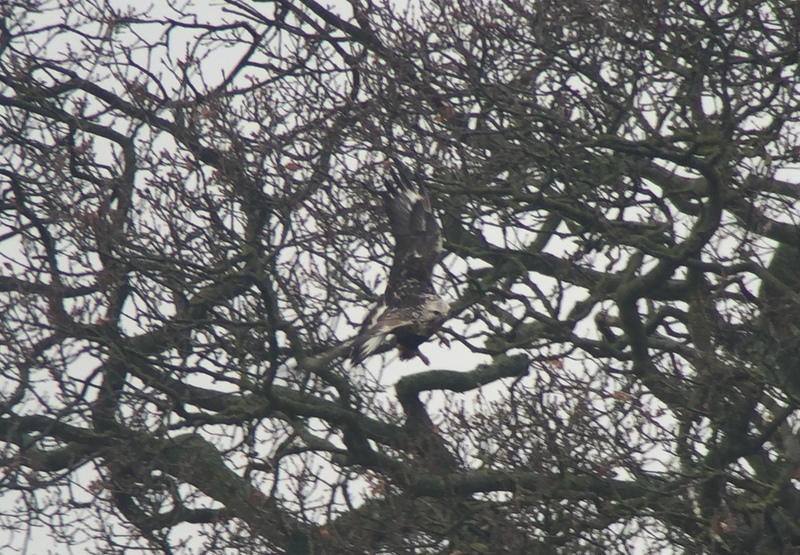 Rough-legged Buzzard – flashing its black-banded white tail in flight
Rough-legged Buzzard – flashing its black-banded white tail in flight
We had a quick look through the scope, then drove round to get a better look. The Rough-legged Buzzard was still perched in the tree across the field in front of us, watching us. Then suddenly it dropped down and flew a short distance across the field, flashing its distinctive mostly white tail as it did so, before flying up into another tree. When it landed we could see why – it had joined another Rough-legged Buzzard which was already sitting there. Two Rough-legged Buzzards for the price of one! We had a fantastic view of them in the scope. In the end we had to tear ourselves away.
 Rough-legged Buzzards – two sat in a tree together!
Rough-legged Buzzards – two sat in a tree together!
We had originally thought we might have a look at Titchwell, but a discussion about some of the other good birds along the coast led to a change of plan. With our luck running, we had seen most of the birds we had hoped to catch up with quite quickly, so we had time to play with. We hopped in the car and headed back east, all the way to Cley.
There has been a Grey Phalarope in the area for several days now and it had been showing this morning from the new Babcock Hide on what used to be Pope’s Marsh. We made our way out to the hide and as soon as we got in there, we could see everyone looking at the mud below. There was the Grey Phalarope, right in front of the hide. Stunning views!
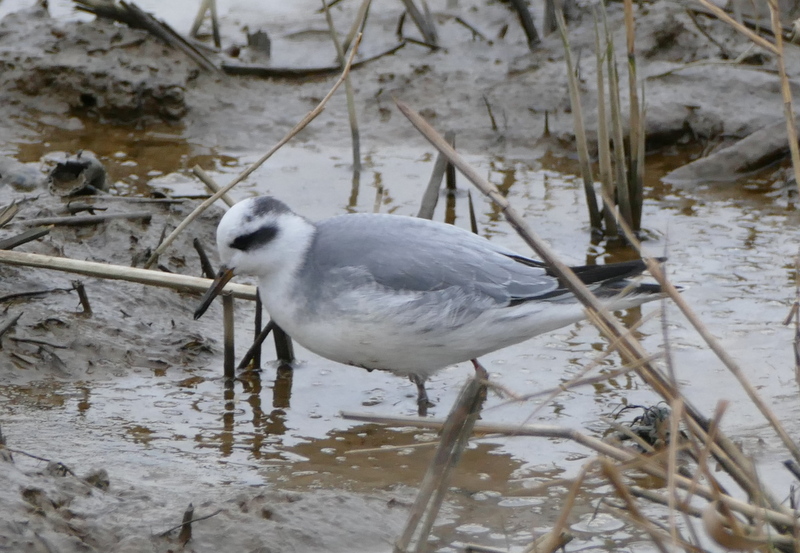 Grey Phalarope – right in front of Babcock Hide
Grey Phalarope – right in front of Babcock Hide
Grey Phalaropes are more often to be seen swimming, twirling in circles to stir up the water and picking for food brought to the surface, or even out on the sea. They are mostly pelagic in the winter, surviving out in the Atlantic, generally only forced in by adverse weather. This one had presumably been blown inshore by the storms we had last week, and had come in to feed up on the marshes.
The water levels have gone down on Watling Water, the new pool in front of Babacock Hide, for the first time. There was a great selection of other waders out on the exposed mud. There were lots of Dunlin, with three larger Knot in with them, down by the water’s edge – a good chance to see the two alongside. A good number of Ruff were feeding higher up the mud, along with a few Redshank. Around the edges of the islands, we could see a few Snipe, well camouflaged against the reeds.
There were several Pied Wagtails around the drier margins of the mud, along with a number of Meadow Pipits. Then, from behind one of the islands, a Water Pipit appeared with them. Larger than the Meadow Pipits, greyer brown and less streaked above and plainer, whiter below.
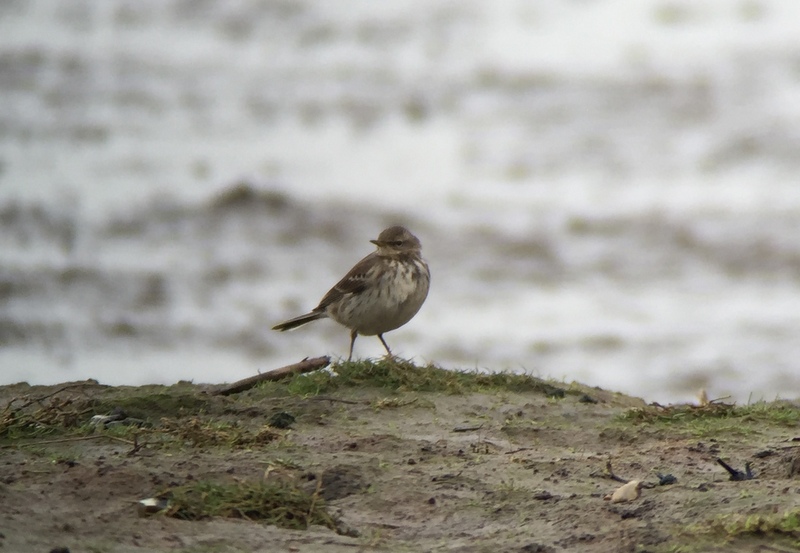 Water Pipit – feeding around the edge of Watling Water
Water Pipit – feeding around the edge of Watling Water
Having seen what we wanted to see so quickly, and so well, we had time to try something else. We drove further along the coast to Weybourne to look for the flock of Redpolls which has been feeding in the fields here for some weeks now. However, the field was harvested a week or so back and when we arrived the few remaining weeds were quiet. We walked up and down the road briefly, but all we could find was a Grey Wagtail which flew up and landed on the wires above briefly. It seemed like our luck had finally run out.
We were just packing up to leave when a flock of about 20 small finches flew in and circled overhead, before dropping down and landing in the hedge nearby. They were Redpolls and we could just see around half of them perched in the top. They were mostly face on to us and several were clearly rather brown around the cheeks and even washed onto the upper breast, Lesser Redpolls. One was clearly different, very frosty around the cheeks and breast, contrasting strongly with the black chin and red ‘poll’, with no brown tones on the underparts and bolder black streaks on the flanks – this was a Mealy Redpoll. Another bird hopped up from lower down in the hedge, and perched back on. It was less distinctive than the first from this angle, but still had a grey (rather than brown) face and looked a rather cold grey brown above with a distinctive pale rump streaked through with black – another Mealy Redpoll.
Unfortunately, they didn’t stop long and flew off strongly west over the field. Still, we couldn’t believe our luck that they should just drop in for us like that. We wanted to end the day at the raptor roost, but we still had a little time to play with, so we drove back to Cley and stopped at the Visitor Centre.
A Red-necked Grebe has been around the reserve for the last few days and was reported from Pat’s Pool today – supposedly visible from the Visitor Centre. We had a quick scan from the car park, but couldn’t see it anywhere around the open water. With the water levels very high, four Avocets were huddled together on the edge of one of the few remaining islands. We decided to pop into the Visitor Centre and get a hot drink to go and use the facilities quickly. While we were waiting, the Red-necked Grebe suddenly appeared close to the bank, wrestling with a small fish. It was distant, but we could see it clearly through the scope.
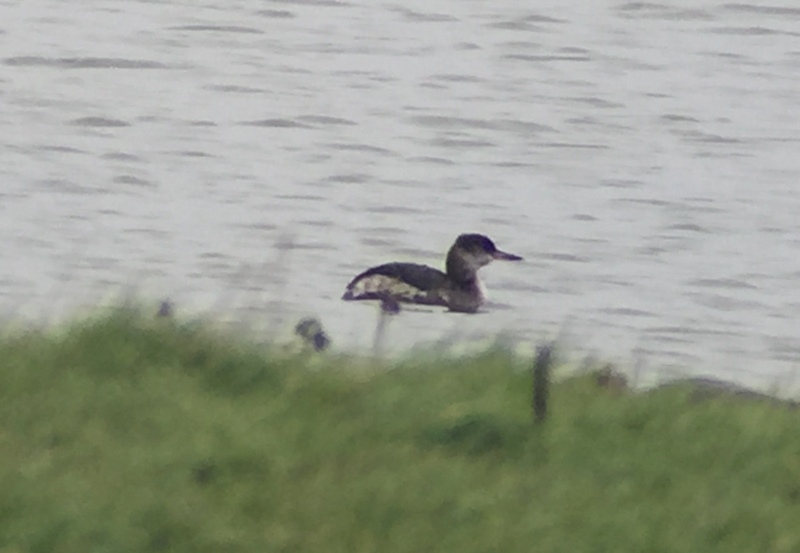 Red-necked Grebe – a record shot, on Pat’s Pool today
Red-necked Grebe – a record shot, on Pat’s Pool today
It disappeared again, then as we returned to the car we could see it further out on the water, diving. We got a better look at it from the car park and it quickly became clear why it was hiding close to the edge. It caught another fish and immediately a Black-headed Gull flew over and started to harass it. The Red-necked Grebe dived, but when it resurfaced half way to the bank, the gull was after it again. This happened three times, before the Red-necked Grebe got over to the bank and finally swallowed its catch.
We finished the day at Warham Greens. There was a nice flock of Linnets and Yellowhammers in the hedge of the walk down to the front, with the odd Reed Bunting in with them. When we arrived, one of the first birds we saw was a Barn Owl which was hunting up and down over the rough grass on the edge of the saltmarsh.
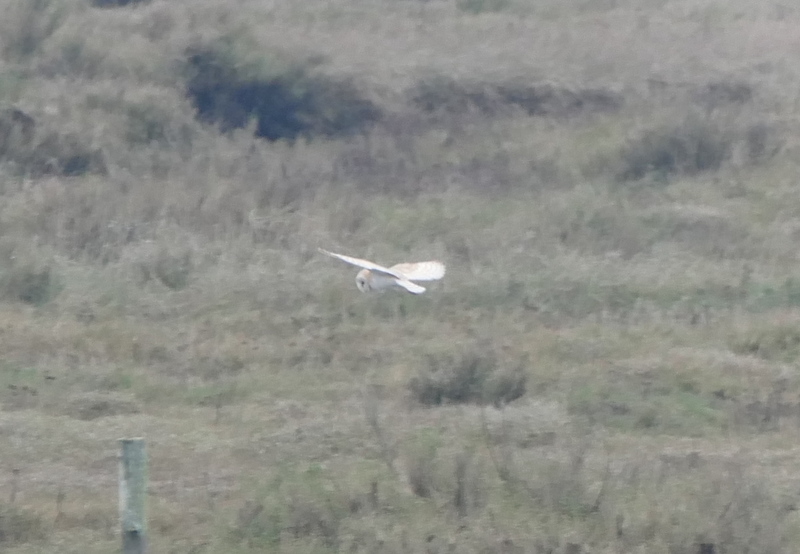 Barn Owl – hunting along the front at Warham Greens
Barn Owl – hunting along the front at Warham Greens
We had really come for the raptors. A couple of Marsh Harriers were circling over the back of the saltmarsh and a single ringtail Hen Harrier drifted in from the east, further back. In the end we saw 2-3 ringtail Hen Harriers, one flying closer across the saltmarsh and away inland, presumably for some last hunting, and another perched preening out in front of us. Then we picked up a Peregrine standing on a sandbar out on the beach. We just needed a Merlin to complete the set here and a careful scan of the saltmarsh eventually produced its reward, with one perched on the top of a bush. Then we decided to head back.
What a day! Pallid Harrier, two Rough-legged Buzzards, Grey Phalarope, Great White Egret, Red-necked Grebe, Water Pipit, Mealy Redpoll, plus a host of other good raptors, waders, geese, ducks and farmland birds. There aren’t many places you could see all of those – welcome to Norfolk in winter.
















